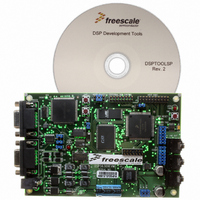DSP56309EVM Freescale Semiconductor, DSP56309EVM Datasheet - Page 4

DSP56309EVM
Manufacturer Part Number
DSP56309EVM
Description
KIT EVALUATION FOR XC56309
Manufacturer
Freescale Semiconductor
Type
DSPr
Specifications of DSP56309EVM
Contents
Module Board, Installation Guide, Power Supply, Cable, Software and more
Description/function
Audio DSPs
Product
Audio Modules
For Use With/related Products
DSP56309
Lead Free Status / RoHS Status
Contains lead / RoHS non-compliant
Load and Edit Code: C/C++ Perspective
3.1
Symphony Studio uses projects to organize different groups of code. To create a new project for the Flash
memory programming code, navigate to the C/C++ perspective then choose File > New > Managed Make
ASM Project. You can also right click in the Navigator View and choose New > Managed Make ASM
Project. The Navigator View is usually on the left hand side of the C++ Perspective. If not, you can open
the Navigator View using the Window > Show View > Other... pull down menu. You can also create a
new project by clicking on the New tool bar button (which looks like a little window with a plus in the
upper corner).
Type a project name in the Project name: field and click on the Next> button. Then click on the Finish
button because the default settings are appropriate for this project. You can now see your empty project in
the Navigator View.
3.2
Next, add the Flash memory programming code to your new project. If you already have the Flash memory
programming code in a file, you can use the import function to add the file to the project. To use the import
function, right click in the Navigator View and choose Import or choose File > Import from the pull down
menu. Choose File System under General and click Next>. Make sure the Into folder: field contains your
project name. Click the Browse button next to the From directory: field. Navigate to the directory that
contains the Flash memory programming code and click the OK button. Click in the box next to the Flash
memory programming code and click the Finish button. You can also add the Flash memory programming
code to the project by dragging it from a file explorer window and dropping it into the project folder in
Symphony Studio.
If you do not have the Flash memory programming code in a file, you can use the new file option. To create
a new file, right click in the Navigator View and choose New > File or choose File > New > File from the
pull down menu. Click on your project name, and type a name for the Flash memory programming code
file (
text of the Flash memory programming code from
window of your new file.
The Flash memory programming code requires that the user code you want to write to the Flash memory
is also loaded into the DSP memory. For this document, we write the audio codec programming code that
is included with the DSP563xxEVM (on the DSP563xxEVME Technical Documentation CD) to the Flash
memory. Therefore, the codec code needs to be added to the project so that it can be loaded to the DSP
memory before running the Flash memory programming code. Locate where the codec files were saved
from the DSP563xxEVM software installation. The codec files should be in a directory called
Tests\Codec_Source. To add the codec files to the project, use the Import function (as described above)
or drag the files from a file explorer window to the Symphony Studio project folder. You need to add the
following files from the Codec_Source directory:
4
•
•
•
•
flash.asm
direct.asm
ada_equ.asm
ada_init.asm
ioequ.asm
Create the Project
Add the Code
works nicely) in the File name field:. Then click the Finish button. Now you can copy the
Using Symphony™ Studio with the DSP563xxEVM, Rev. 0
Example 5
of this document and paste it into the editing
Freescale Semiconductor










